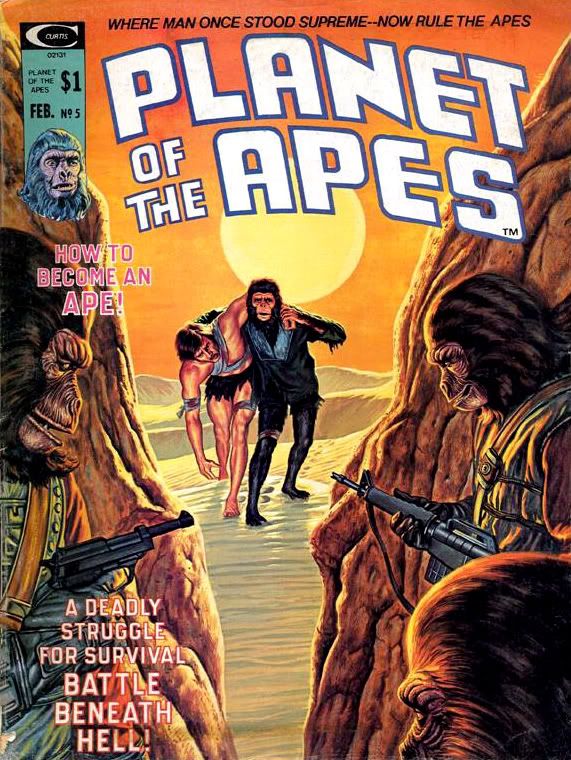 Ahhh... the old Marvel/Curtis Planet of the Apes magazines. How I love them. Lurid painted covers by Bob Larkin, Earl Norem and even Grey Morrow, twisted stories by Doug Moench, black and white art by Mike Ploog, plus Tom Sutton, Ed Hannigan, Alfredo Alcala and more…
Ahhh... the old Marvel/Curtis Planet of the Apes magazines. How I love them. Lurid painted covers by Bob Larkin, Earl Norem and even Grey Morrow, twisted stories by Doug Moench, black and white art by Mike Ploog, plus Tom Sutton, Ed Hannigan, Alfredo Alcala and more…Looking back, my parents probably shouldn't have allowed me to read these. But they did. Why?
Well, my dad was not very literary; he fell asleep reading the sports pages almost nightly. So I doubt he had even a vague awareness of the kind of crazy crap I was being exposed to via comic books, although he shared my love for Li'l Abner and Dick Tracy in the funny pages. My mom, on the other hand, was always taking me to the library, always had books on hand and, despite her own conservative leanings, never once banned a book in our house, never once tried to restrict my reading material. I was reading John Irving before puberty, for crying out loud!
But the Planet of the Apes magazines were aimed at older teens and adults, not overly imaginative first graders who began reading at age four. And far more importantly in our two-income-out-of-necessity household, they were expensive. One dollar might as well have been one million to a kid whose personal economy relied heavily on finding pennies under the sofa cushions. And even when I came into birthday or Christmas wealth, who the hell would pay a dollar for a stupid funny book? In 1974, no sane six-year-old would.
And these days? Only a lunatic, a victim of backwoods inbreeding, or some irradiated mutant comic book fan squatter living in the abandoned city of Pripyat in the Chernobyl Exclusion Zone, his mind ruined from all the tellurium and rubidium radioisotope-infused air he's been breathing for more than twenty years, would even consider forking over such an exorbitant sum for a damn comic. Right? Am I right? Of course I am. You and me, we're good, normal people, not money-wasting degenerates! Or worse, hippies!
In 1974, I could get four regular-sized color comics for a buck, and those rarely caused me to sleep with the light on. But somehow or other I convinced my mom to pay a ridiculous price for Planet of the Apes #5 so I could have a big, scary magazine about my favorite movie series. She must've thought it would be as harmless to my psyche as the watered-down TV show with the forever-awesome Roddy McDowall.
Speaking of the late Mr. McDowall, the chimp on the cover looks a lot like him in Cornelius make-up. I eventually decided it was Roddy McDowall after spending countless hours just staring at Bob Larkin's gorgeously weird cover illustration. I felt enormous sympathy for the human-ape friendship, soon to be spoiled by some angry gorillas waiting in ambush. That poor wounded duo dragged their asses miles across a desert wasteland-- and you can almost feel the dry heat pouring down on them from the orange sky-- only to run into what appears to be a prototypical ape general (note his studded collar denoting senior rank) and a couple of his gorilla thugs. Ape society frowns on inter-species fraternization.
 Well, if my mom bought it for me (possibly to shut me up before I caused a scene) because she was convinced this magazine would prove harmless, she was wrong. Seriously wrong.
Well, if my mom bought it for me (possibly to shut me up before I caused a scene) because she was convinced this magazine would prove harmless, she was wrong. Seriously wrong.
"Reading is good for your growing brain," she probably said to me at the time. She really should've at least scanned its contents before tossing it into the shopping cart with the ice milk and bananas. If she had, she'd have known the lead story was a little horror piece by Moench titled “Evolution’s Nightmare.”
No, Dougie-doug, your story was my nightmare. As in the bad dreams it caused me every time I dared pluck it from the stack of Spider-man, Sgt. Rock, Archie (including Spire’s Christian Archie), the Gold Key Star Treks and Richie Rich comics I buried it under, hoping to muffle its wicked siren call…
Never to read it again. Never to spend another sleepless night with the room light on and the covers pulled up over my head, a little breathing hole to let cool air in instead of breathing warm, stale air. But read it I did, time after time, always with the same damned result!
Anyway, "Evolution’s Nightmare” is, like many of Moench’s Apes tales, totally outside the scope and continuity of the movie series that inspired it. In Moench’s imagination, starkly rendered in ink for all to see by Ed Hannigan and Jim Mooney, humans and apes went through a sort of medievalist period where they wore ornate armor (fashions by Conan of Beverly Hills) and fought with swords and axes. As the story begins, two armies of men and apes prepare to battle it out for species supremacy in the Forbidden Zone. In floridly written captions and dialogue, Moench relies on repetition and parallelism to compare and contrast the two groups, then annihilates them. He leaves just two survivors, but gives Jovan (the human) shattered legs and Solomon (the ape) useless arms.
 They reluctantly team up for survival, Jovan secured atop the Solomon’s shoulders with bandages. It’s a sci-fantasy version of “The Defiant Ones,” with the same lessons in tolerance, only this time taught by giant mutant boars and deformed bunny rabbits with frog eyes. After a few adventures, the ape and the man heal under the care of Mordecai, a mysterious hermit who appears to be a hybrid of human and simian.
They reluctantly team up for survival, Jovan secured atop the Solomon’s shoulders with bandages. It’s a sci-fantasy version of “The Defiant Ones,” with the same lessons in tolerance, only this time taught by giant mutant boars and deformed bunny rabbits with frog eyes. After a few adventures, the ape and the man heal under the care of Mordecai, a mysterious hermit who appears to be a hybrid of human and simian.
Then, because their hate is so strong, they beat each other until they both collapse in a heap from exhaustion. Mordecai boots them from his cave, telling them, "Go now. I do not wish to know who has 'won' your contest. I do not wish to look upon either of you ever again... ...for while I am neither human nor ape... ... I am both-- and you have shamed me twice-over this day."
 Shamed as well, the duo make their way to a ruined San Francisco, marvel at its desolation, then resolve to become friends... and once again Moench provides an ironic parallelism as mutant apes and humans devolved to a Stone Age state choose just that moment kill our protagonists and repeat the same aggressive posturing that opens the story. “Circles,” Moench concludes, “They repeat themselves. Circles. They stink.”
Shamed as well, the duo make their way to a ruined San Francisco, marvel at its desolation, then resolve to become friends... and once again Moench provides an ironic parallelism as mutant apes and humans devolved to a Stone Age state choose just that moment kill our protagonists and repeat the same aggressive posturing that opens the story. “Circles,” Moench concludes, “They repeat themselves. Circles. They stink.” Oh yeah, I definitely had no business reading this as a child. I'd only been literate for about two years and still had very poor reading comprehension, especially versus Moench’s overwrought narration. I could barely parse sentences such as, “And still it continues, corpses gathering... ...Combatants dwindling. Conservation of exploding energy transmuted to lifeless matter littering dead ground soaking wasted blood.” Corpse, corpse, corpse. I think I learned the word "corpse" from this story.
Oh yeah, I definitely had no business reading this as a child. I'd only been literate for about two years and still had very poor reading comprehension, especially versus Moench’s overwrought narration. I could barely parse sentences such as, “And still it continues, corpses gathering... ...Combatants dwindling. Conservation of exploding energy transmuted to lifeless matter littering dead ground soaking wasted blood.” Corpse, corpse, corpse. I think I learned the word "corpse" from this story.
But I could easily grasp the story’s overall theme of the cyclical destructiveness of hate. I mean, Moench hammers it home with all the subtlety of Rocky's fists pounding those sides of beef in Pauly's meat locker. This story is so heavy-handed just to read it gives your forearms and biceps an amazing workout. You'll feel the burn about three pages into it, and at that point you really need to check your heart rate. Consult your physician before reading "Evolution's Nightmare."
I suppose most disturbing-- even more so than Hannigan's vivid artwork-- was that relentless pessimism, which matched the film series’ downbeat tone. Rarely is popular entertainment these days so bleak as it was in the 70s. Moench suggests humanity’s flaws are genetic, primates of any species are hopeless, so even if we learn our lessons, there are still others who refuse to, and they’ll clop us in the heads with stones and all that newborn love will spill out uselessly onto the shattered, radioactive asphalt.
Here's the ultimate reason I shouldn't have been allowed to read this-- precocious as I was, I was not capable of metaphoric thought. So I believed “circles” to be the name of the savage mutants at the end, and they scared the living shit out of me. To me, Moench's final lines about how they repeat themselves meant the mutants ran around saying everything twice. My middle brother tortured me whenever he felt particularly impish—“I’m a circle! I’m a circle!” he would croak. “I’m going to get you! I’m going to get you!” And I’d scream and scream until my mom got pissed at the both of us.
A recurring fear of mine was I'd open the wooden shutters of my bedroom one night and the circles in their furry loincloths and with their long, pointy fingernails would be cavorting under the streetlights and jumping up and down on our neighbors' cars in their driveways. And they'd see me looking out at them... little itsy-bitsy me with my Beatles haircut and my stupid freckled face and gapped baby teeth...
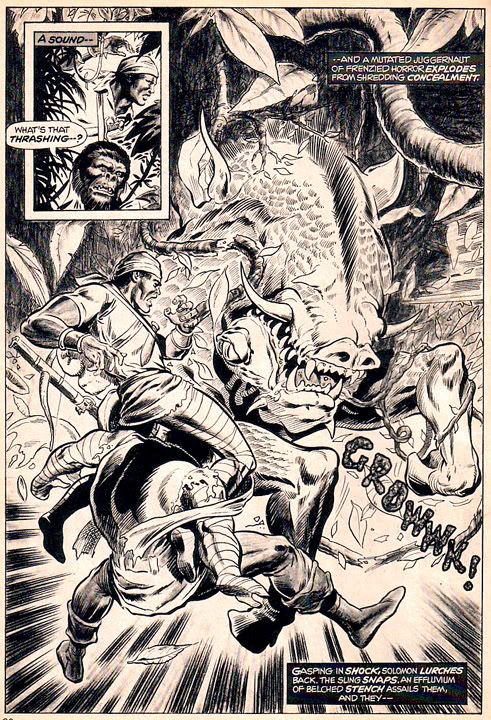 Circlephobia aside, by daylight, I loved drawing clumsy imitations of Hannigan’s body-strewn panels. You know, the battle’s aftermath, piles of the dead with swords, broken spears and torn banners poking out of them. The twisted arms, the lifeless eyes rolled back in their sockets. I covered huge sheets of cheap newsprint sketchbook paper with vistas of dead apes and men in a tangle. What a freak I was! Young Tim Burton would’ve shuddered.
Circlephobia aside, by daylight, I loved drawing clumsy imitations of Hannigan’s body-strewn panels. You know, the battle’s aftermath, piles of the dead with swords, broken spears and torn banners poking out of them. The twisted arms, the lifeless eyes rolled back in their sockets. I covered huge sheets of cheap newsprint sketchbook paper with vistas of dead apes and men in a tangle. What a freak I was! Young Tim Burton would’ve shuddered.After the madness of the issue’s lead feature, the backup story was soothing. It’s a chapter from Moench’s rather straightforward adaptation of the first Planet of the Apes movie, the Heston one. Familiar stuff, since CBS ran the flick not long before. But George Tuska’s art didn’t really impress me as a kid. It seemed prosaic, sort of cartoonish, and not in an especially good way. But then, I was more of a Russ Heath/Neal Adams/Alfredo Alcala kid in those days. Stylized bombast is fine in a superhero comic, but out of place in a science-fiction story. Especially one so depressing. And Tuska’s Taylor looks like some kind of hyper-muscular hippie dressed in a cheap Tarzan suit for a costume party, although he still says many of Charlton Heston’s lines.
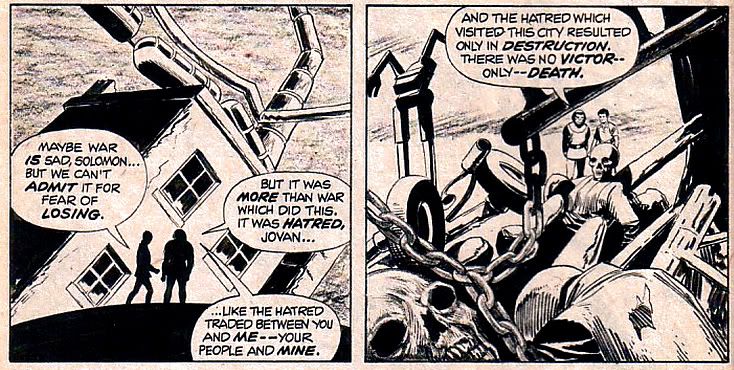 The funniest sequence is where Nova runs off by herself, and Zira comes back to tell Taylor, “She thinks that if she does not return to her people-- --She will die!” If I remember correctly—and at this point, I sincerely doubt I do—this is a remnant of a discarded subplot from the film itself. Nova is actually supposed to be pregnant, which explains why Tuska gives Taylor a gaping, shocked response that seems over the top compared to the stimulus. Who cares that much about some stupid, primitive belief?
The funniest sequence is where Nova runs off by herself, and Zira comes back to tell Taylor, “She thinks that if she does not return to her people-- --She will die!” If I remember correctly—and at this point, I sincerely doubt I do—this is a remnant of a discarded subplot from the film itself. Nova is actually supposed to be pregnant, which explains why Tuska gives Taylor a gaping, shocked response that seems over the top compared to the stimulus. Who cares that much about some stupid, primitive belief?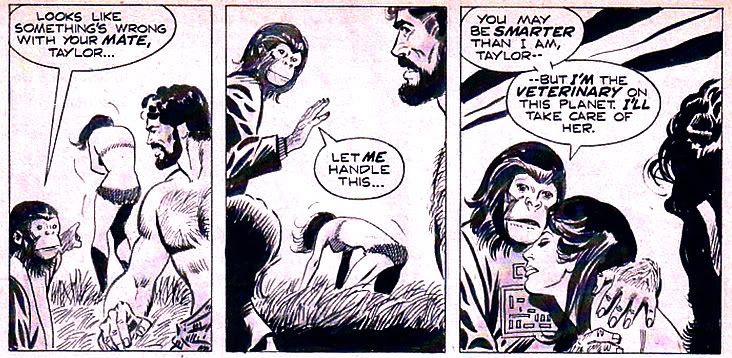 Look at the actual drawings. Nova staggers away holding her stomach, then drops to her knees in the tall grass. She's obviously yakking her guts out. Morning sickness! Even I can figure that out, and I'm an idiot. But how exactly does Zira come up with her silly alternate theory? As a veterinarian, she'd obviously recognize pregnancy symptoms. She’s also an animal psychiatrist… but Nova has no language and no culture, no way for Zira to infer anything beyond Nova's physical state because Nova exists on a thoughtless, animal level.
Look at the actual drawings. Nova staggers away holding her stomach, then drops to her knees in the tall grass. She's obviously yakking her guts out. Morning sickness! Even I can figure that out, and I'm an idiot. But how exactly does Zira come up with her silly alternate theory? As a veterinarian, she'd obviously recognize pregnancy symptoms. She’s also an animal psychiatrist… but Nova has no language and no culture, no way for Zira to infer anything beyond Nova's physical state because Nova exists on a thoughtless, animal level.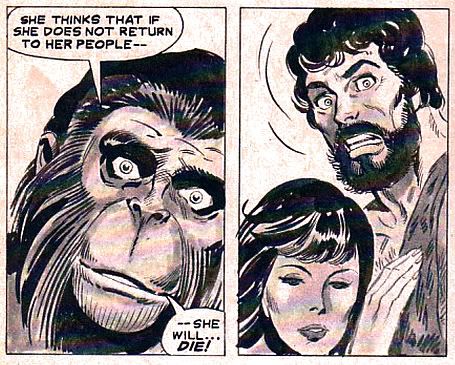 There's even a strange chunk missing from the top of Zira's head, as if a paste-up job went slightly awry. And it probably doesn't matter. Fear of death or pregnancy, Nova's subplot is dropped and never mentioned again. She doesn't die in the story, she doesn't carry Taylor's bastard child to term.
There's even a strange chunk missing from the top of Zira's head, as if a paste-up job went slightly awry. And it probably doesn't matter. Fear of death or pregnancy, Nova's subplot is dropped and never mentioned again. She doesn't die in the story, she doesn't carry Taylor's bastard child to term.Still, I like thinking about these things. I can understand why the producers of the movie would self-censor; after all, in 1968, it was safer to hint around at their romance than to admit outright Taylor and Nova were mating in their cage like beasts. Unmarried beasts at that, and Taylor an evolved, thinking creature. Kinda sick, that power exchange, huh? But the pregnancy dialogue remains intact in the four-color monthly, which was supposedly more child-friendly. So why change the pregnancy dialogue in the more adult-oriented magazine, especially after the first story includes so much carnage and even a rape metaphor?
Only Doug Moench knows for sure!

5 comments:
LOL - great article, and the trauma reminded me of the fuss that went on when those parents took kids to see Conquest of the Planet of the Apes thinking it'd be just a cute, fun film with monkeys, and seeing instead a violent apocalyptic nightmare - and rated PG too!
Thanks, Derek! I had a lot of fun revisiting this magazine. Ah... Conquest. Yeah, I can imagine kids with their eyes practically rolling in their sockets from horror at the film's climatic carnage, and the image of the burning building behind Caesar!
Joel- Fantastic article. There was something really unique about those B/W Apes comics.
Doug Moench took what was an already highly imaginative concept and created incredibly lush worlds with it.
In fact, I named my blog after one of his titles (one of the all-time great story titles):'Up the Nose Tube to Monkey Trash'.
I think my favorite series from the Apes books was 'Future History Chronicles'. Ape cityships! Freaky!
Great blog...I hope you don't mind me linking to you...
Thanks a bunch Pete! Yeah, the city-ships are amazing and Tom Sutton really pulled out the stops in illustrating those stories. I'll be forever impressed the way Doug Moench took the basic Apes concept and just ran with it. It's like sci-fi psychedelia on newsprint.
Link away, and allow me to reciprocate. I've read your blog before and always loved that title!
Hi Joel,
This is Caesar from Madrid, Spain...yes, in Europe. The comic that destroyed -absolutely- my mind was, indeed, Planet of the apes nº5, in 1976.
I love it so bad, dude :)
Please write to me to: caesaremperor@yahoo.com if you want to see scans of the unbelievable Spanish edition of this comic, you´ll be astonished :)
Thanks so much for such a great article, hope to hear from you!
P.S: Hey guy, what can you tell me about number 20?!? That Psychodrome´s Society is so amazing! And what a cover!!!!
Post a Comment